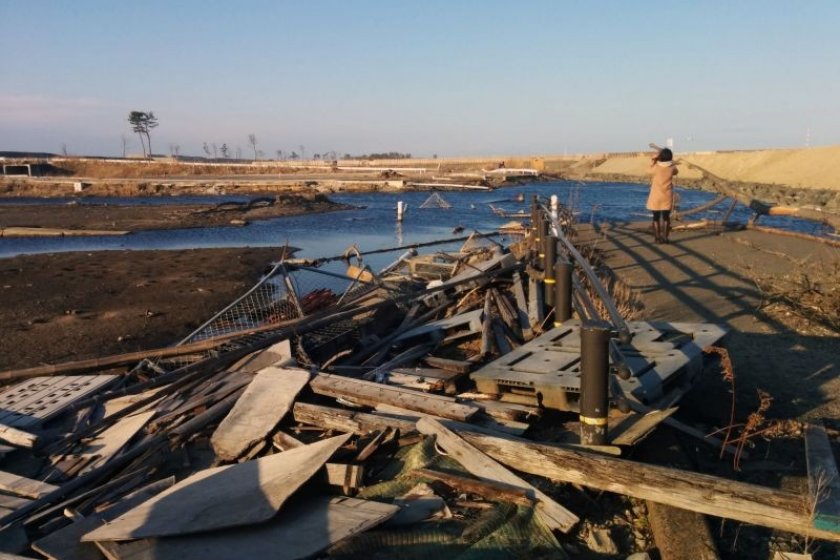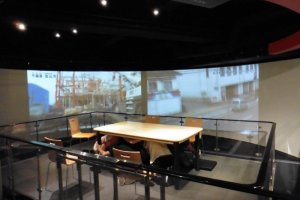Being on a major fault line, Japan experiences many earthquakes every year. Most of these are small and benign, however, there are large and even devastating earthquakes at times. Japan is the country with the highest natural disaster risk in the world among developed nations. However, nature cannot be conquered, and earthquakes are a part of Japanese life. People can only learn to prepare themselves for the worst.
Our typhoon guidance has moved – please see our typhoon guide for our up-to-date article on what to do if traveling in Japan during a typhoon.
Overview
Earthquakes can cause severe damage to buildings and other infrastructures, such as water and power outages, and can significantly hinder transportation systems. Earthquakes may even lead to tsunamis in coastal areas, while also increasing volcanic activity. Though most urban buildings have been constructed to meet the latest safety standards, wooden houses in the countryside are susceptible to much greater danger, and residents there need to take extra caution and preparation.
Earthquakes
Japan is the most seismically active country in the world and experiences about 1,500 earthquakes annually, although the majority of them are barely felt. Instead of the commonly used Richter Scale, Japan applies the shindo scale, which measures the strength of an earthquake by 10 different levels – from 0 to 7, with 5 and 6 being divided into “upper” and “lower” (for example, the 2011 Tohoku Earthquake registered a 5-upper in Tokyo).
Anything above a shindo 5-lower is considered major, while anything below a 2 is minor. Japan averages roughly one or two major (shindo 6 level) earthquakes per year, with damage suffered to varying degrees.
Though earthquakes occur frequently in all areas of Japan, the Sanriku area (Aomori, Iwate, Miyagi) and the prefectures along the Sea of Japan coast (Fukui, Ishikawa, Niigata) have historically been prone to the most seismic activity.
Recent major earthquakes include the Great Hanshin Earthquake on January 17, 1995, which resulted in 6,434 deaths and caused great destruction to the city of Kobe, and the Great East Japan Earthquake, which occurred on March 11, 2011, and not only claimed over 15,000 lives but was also the costliest natural disaster in world history, with property damages totaling $235 billion, while the ensuing tsunami triggered the Fukushima Nuclear Power Plant disaster.
It has been said that the Kanto and Tokai areas have a significant chance of experiencing a major earthquake within the next couple of decades, making earthquake preparation all the more vital, both on an individual level but also Japan's industries.
What to do in an earthquake
Advance preparation
-
Know your neighborhood’s designated evacuation area (hinanjo) and how to get there beforehand (usually a school or park).
-
Pack a survival kit in case you need to evacuate (see above) or power and water outages. Survival kits should include:
-
bottled water (enough to last a few days)
-
blankets
-
flashlight + batteries
-
chargers
-
radio
-
some money
-
nonperishable food (enough to last a few days)
-
can opener
-
first aid (medicine, band-aids, etc.)
-
personal identification documents and travel documents if you're a non-resident
- pen & notebook (write down important contact info – telephone numbers of family, friends, embassy, etc.)
-
-
Make sure furniture and other objects are relatively stable and avoid placing unsecured objects in high areas. Avoid having objects in or near doorways, and near fire sources. You can use suspension rods to secure large objects, like bookshelves.
During an earthquake
-
When an earthquake happens or when you receive an Earthquake Early Warning, quickly turn off all gas items in order to prevent fires and take cover, ideally under a chair or table, although doorways and near pillars can also be relatively safe. Cover your head and neck with a pillow, seat cushion, or your hands. Stay away from windows or large, unstable fixtures.
-
If outside, drop and cover your head and neck with a bag or your hands (ideally in an open area), while staying away from windows, coastal areas, and rivers. If you are on public transportation, do the same and then follow the instructions given by the conductor or driver.
-
If driving, pull over to a safe area and stay inside the car. Turn off the engine and listen to the radio for updates. if you need to evacuate, get out of the car and leave the door unlocked with your keys inside the car; this makes it easier for rescue squads to clear the road if necessary.
-
Although most earthquakes tend to last no more than 10 seconds or so, remain in the aforementioned position for a few minutes, as falling objects and aftershocks may follow.
-
Do not move unnecessarily; you will not outrun an earthquake. Stay inside unless you are told to evacuate; trying to leave work or school all at once will cause the transportation system to overflow and become inefficient.
-
In case of a tsunami warning, immediately evacuate to the designated evacuation spot of the neighborhood, or to higher ground.
-
Do not use elevators when evacuating; there may be aftershocks, which could cause you to become trapped inside.
-
If you are trapped inside an elevator, press the emergency button (usually marked with a phone symbol) to communicate with rescue services. Many new elevators are equipped with an emergency box, which contains supplies in case you are trapped for hours or days.
-
Above everything else, try to stay calm and don’t panic.
Staying in touch
During the Tohoku Earthquake, social networking services such as Facebook, Twitter, and LINE played a huge part in helping to confirm the safety of family and friends, while Skype allowed verbal communication.
NTT’s Disaster Message Service is an analog method but useful when data and Wi-FI connections are down, due to too many people accessing them at all once. Follow the steps below to leave and receive messages, or consult NTT's own guidance:
-
How to leave a message
-
Dial 171, then dial 1 to select record
-
Dial the other person’s number
-
Dial 1, #, record your message, then dial 9, then # to save the recording.
-
-
How to check for left messages
-
Dial 171, then dial 2 to select playback
-
Dial the number of the person who may have left you a message
-
Dial 1, #, listen to the message(s)
-
Softbank, AU, and ymobile (J) offer similar disaster messaging services.
Getting up-to-date information
-
For a list of emergency contact numbers, check out the Contact Info During Emergencies guide.
-
The MegaNet is Japan’s only network of multilingual radio stations, serving 10 languages (English, Japanese, Korean, Chinese, Tagalog, Thai, Bahasa Indonesia, Spanish, Portuguese, and French) and broadcasting public service announcements in all of them. The MegaNet stations are:
-
InterFM (Kanto Area) — 76.1 FM or 89.7 FM, 76.5 FM for Kanagawa
-
InterFM Nagoya (Nagoya & surrounding areas) — 79.5 FM
-
FM Cocolo (Osaka, Hyogo, Kyoto, Nara) — 76.5 FM
-
Love FM (Fukuoka & Saga) — 76.1 FM, 82.5 FM for western Fukuoka, 82.7 FM for Kita-Kyushu
-
-
On television, NHK (Channel 1) is Japan’s national public broadcasting organization and provides news at the top of every hour. NHK Radio 1 can be accessed at 594 AM.
-
The weather forecast and weather information can be heard by dialing 177 on the phone (in Japanese only).
-
Earthquake Information by the Japan Meteorological Agency
-
Japan Earthquakes (Twitter) — Provides the latest updates on earthquakes in Japan.
Useful apps
Most Japanese phones have Earthquake Early Warnings pre-installed; it has been said that the warnings saved many lives during the Tohoku Earthquake. Though most tend to come around 10 seconds before the tremors start, those seconds could very well be the difference between life and death. The following are useful smartphone apps for earthquakes which you may want to download before your trip as a precaution.
-
Safety Tips (iPhone / Android) – Receives Earthquake Early Warnings & Tsunami Warnings, and has information on what to do during an earthquake, as well as useful information during disasters
-
Yurekuru (iPhone) – Push notification app that gives notifications of earthquake warnings and expected magnitude
-
Earthquake Alert (Android) – Shows information for earthquakes happening around the world
-
Twitter (Android / iPhone / Windows Phone) – Not just useful for letting your followers know that you are okay, a number of organizations also support Twitter Alerts, allowing them to push crisis information to subscribers in real-time. Currently, these services are only available in Japanese.



























